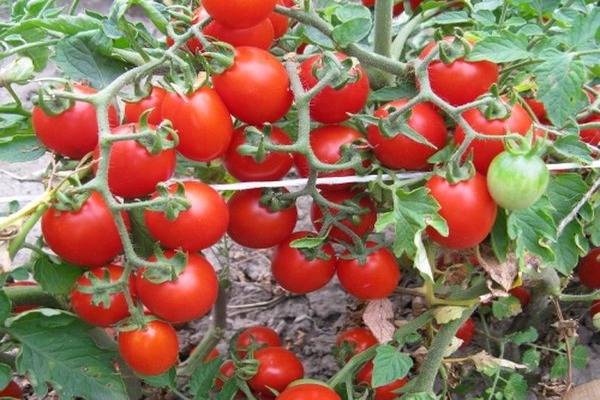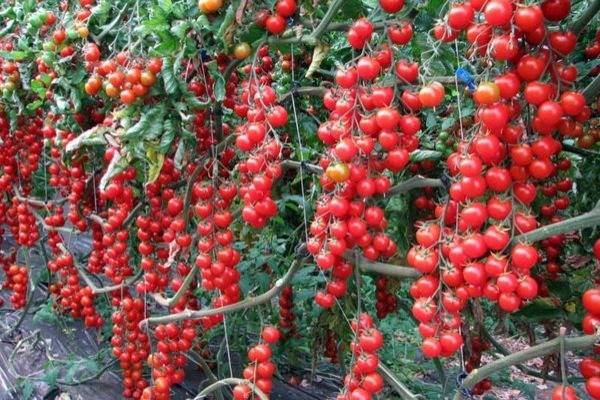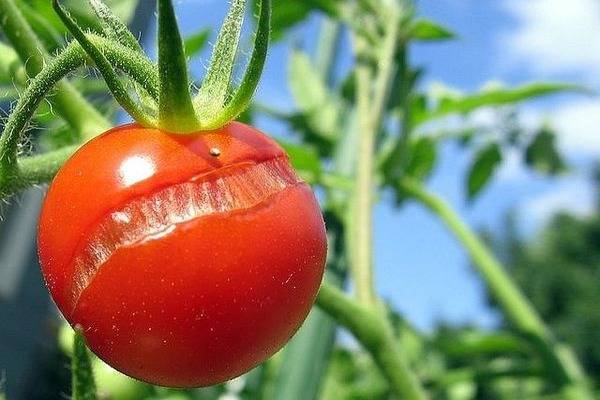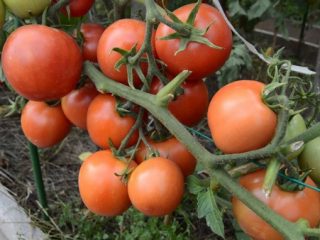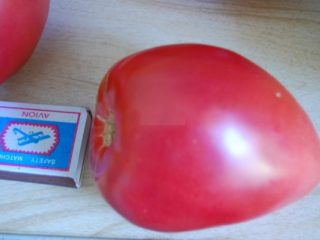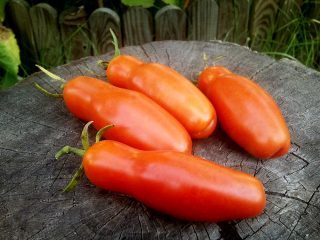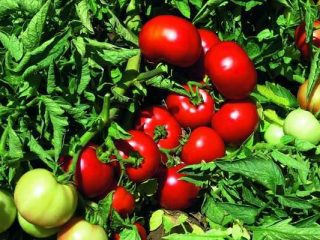Content
Naturally, every summer resident has his favorite tomato varieties. Some people love fleshy large fruits, while others prefer neat tomatoes that can be cut into a salad or perfectly preserved. Of particular interest are tomatoes, which are easy to grow in a summer cottage or even on a balcony. The Thumbelina tomato belongs to just such varieties.
Characteristics of the variety
Early ripe Thumbelina is intended for growing indoors. On average, the bush grows to a height of 1.5-1.6 m. The period from seed germination to the first harvest is 91-96 days. The fruits ripen small - 15-20 grams each, but 10-14 fruits can be formed in a cyst (photo). The round tomato variety Thumbelina has a smooth and dense skin and, according to reviews from summer residents, has an excellent taste.
Approximately 4.5 kg of ripe fruits are collected from a square meter of bed. The Thumbelina tomato perfectly complements vegetable salads and looks delicious when preserved.
The main advantages of the Thumbelina variety:
- self-pollinating tomato, which is especially important if you want to grow tomatoes on a balcony or loggia;
- resistance to many tomato diseases (powdery mildew, rot);
- friendly ripening of tomatoes of the Thumbelina variety.Since all the tomatoes ripen at the same time on one bunch, harvesting is a pleasure. You can pick individual fruits or immediately cut off an elegant bunch of tomatoes.
The disadvantage of this variety is its sensitivity to sudden temperature changes. The Thumbelina tomato also reacts poorly to low temperatures, so it is recommended to grow this variety only in greenhouses.
Planting seeds
To sow Thumbelina tomato seeds, a special soil mixture is used. You can also prepare the soil yourself - mix garden soil, humus/peat, sand and mineral fertilizers. To disinfect the soil, you need to heat it in the oven.
Before sowing, tomato seeds of the Thumbelina variety are first immersed in a solution of potassium permanganate for 3-4 minutes (for disinfection). Then the grains are washed and wrapped in a wet cloth for germination for 2-3 days.
Keep the napkin in a warm place and do not allow the fabric to dry out. As soon as the seeds germinate, you can plant them in the ground. First, a drainage layer is poured into the containers, and then a special soil. On the surface of the moistened soil, grooves are made about 1 cm deep. The seeds are laid out in the grooves at a distance of 2 cm from each other and covered with a thin layer of soil. To germinate the grains, the container is placed in a warm place (temperature +20-25˚ C) and covered with glass or film. Usually shoots appear on the 5-6th day.
To strengthen and fully grow seedlings of the Thumbelina variety, additional light sources are equipped (it is recommended to install a special phytolamp).
When the sprouts have 2-3 leaves, the seedlings can be picked and planted in separate containers. You cannot delay picking seedlings, otherwise the growing plants will form such a root system that later planting will become very traumatic for the Thumbelina tomato sprouts.
You can pick quite late (when the seedlings already have 5-6 true leaves). But in this case, seedlings are planted in advance more rarely or the seedlings are carefully thinned out using the usual planting scheme.
To plant Thumbelina seedlings, cups (200-250 grams in volume or special pots measuring 8x8 cm) are prepared in advance. You should not take containers that are too spacious in anticipation of the future powerful root system of tomatoes. Since in soil that is not occupied by roots, a fungus can grow, which will lead to disease in tomatoes of the Thumbelina variety.
The issue of pinching the central root remains controversial. On the one hand, such an operation stimulates the growth of a powerful branched root system. On the other hand, such injury to seedlings inhibits their growth for some time. In addition, when replanting, part of the thin long root is already torn off.
Seedling care
After transplanting Thumbelina tomatoes, it is recommended to place the containers for 2-3 days in a shaded place. Then the seedlings are provided with good lighting. And after a week or a week and a half, they begin to gradually accustom the sprouts to fresh air.
The first fertilizing is applied one and a half weeks after planting the Thumbelina variety sprouts.You can use complex special fertilizers or make a solution yourself: 12 g of potassium sulfate, 35 g of superphosphate and 4 g of urea are dissolved in 10 liters of water. It is advisable to combine watering and fertilizing.
When watering Thumbelina tomatoes, do not allow water to stagnate. It is recommended to water the tomatoes as the soil dries out.
This is especially true for tall varieties of tomatoes, which in cramped pots can slow down growth.
Tomato care
Thumbelina tomato seedlings can be planted in a greenhouse 40-50 days after seed germination (usually in mid-May). The soil in the greenhouse must be prepared in advance.
When digging up the soil, add compost or humus at the rate of 4-6 kg per square meter of area. This is important if tomatoes have been growing in one place for several seasons.
The Thumbelina variety prefers fertile, loose, neutral mixtures. In the greenhouse, the bushes are planted at a distance of 60-70 cm from each other. Provide support for tomatoes in advance - as soon as the seedlings grow to 30 cm, it is necessary to tie up the stem.
Excellent yield is obtained when bushes are formed with 2-3 stems. Usually the bushes grow to a height of 1.5 m. The main care consists of regularly tying up Thumbelina tomatoes, removing the shoots and loosening the soil. To prevent the soil from drying out, it is advisable to mulch it.
Fertilizers must be applied during the periods of flowering, ovary formation and fruit formation. It is allowed to use both organic (peat, humus) and inorganic fertilizers (Kemira Universal 2, Magnesium Sulfate, Mortar).
Diseases and prevention
According to reviews from summer residents, the Thumbelina variety is quite resistant to disease. However, you should be aware of the diseases that can affect tomatoes:
- Tobacco mosaic virus occurs in greenhouse conditions due to poor ventilation, high air humidity, and thickening of bushes. The disease manifests itself in the form of light green and yellowish mosaic spots. Plants quickly break, Thumbelina fruits burst. The virus is spread by aphids and thrips. At the first symptoms, the damaged bush should be treated with a whey solution (10%) with the addition of microfertilizers. As a preventative measure, it is recommended to replace the top layer of soil in the greenhouse (approximately 10-15 cm);
- Late blight is one of the most common fungal diseases. A favorable environment for the occurrence and spread of the disease is cloudy, cool and humid weather. There is no absolute cure for fungus. Therefore, at the first symptoms, it is important to prevent the spread of the disease. As a preventative measure, bushes are treated with Fitosporin, Gamair, Alirin. It is recommended to spray Thumbelina tomatoes when the first ovaries form. You can also water the soil with the preparations or add them to irrigation water. In autumn, carefully remove the remains of tomatoes. In the spring, the walls of the greenhouse can be washed or the polyethylene covering can be replaced.
Fruit cracking cannot be called a disease. Rather, it is a flaw that appears when the soil is over-moistened.To prevent the occurrence of such defects, the soil is regularly loosened and the irrigation process is controlled.
Tomatoes of the Thumbelina variety will pleasantly decorate the summer table and join the ranks of elegant preserves. Simple care allows you to grow several tomato bushes without much hassle.
